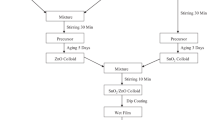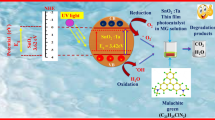Abstract
Undoped, Sn3+-doped, and Sn3+/Zn2+-codoped In2O3 films were synthesized using a time- and cost-efficient spin-coating technique. XRD analysis confirms that all films crystallize in a single cubic bixbyite phase. Morphological and roughness changes associated to Sn3+/Zn2+-doping are revealed by both AFM and SEM analysis, while FTIR and XRF analysis confirm the incorporation of Sn3+/Zn2+ into the In-sub lattice of the In2O3 structure. UV–Vis. analysis demonstrates that the doping shifts the absorption edge towards longer wavelengths, widens the Urbach’s tail and reduces the gap energy. Room-temperature photoluminescence (PL) spectra display four main bands, their intensities decreasing upon doping. EIS analysis proves that the doping and codoping decreases the electrical impedance of the films. Moreover, the introduction of Sn3+/Zn2+ into the In2O3 lattice enhances the photo-degradation of methylene blue (MB), finally, a proposed photocatalytic mechanism is presented.










Similar content being viewed by others
Data availability
The datasets generated and/or analyzed during the current study are available from the corresponding author on reasonable request.
References
M. Ghemid, H. Gueddaoui, M. Hemissi, M.R. Khelladi, R. Bourzami, Thickness effect on structural, optoelectronic properties and photocatalytic activity of low-cost spin-coated In2O3 films. Chem. Phys. Lett. 784, 139089 (2021)
M. Ghemid, H. Gueddaoui, R. Brahimi, M. Trari, Simple and effective synthesis via sol–gel of Zn-doped ITO films and their microstructural, optical, and photoelectrochemical properties. Appl. Phys. A 128(816), 1–15 (2022)
N. Xia, R.A. Gerhardt, Fabrication and characterization of highly transparent and conductive indium tin oxide films made with different solution-based methods. Mater. Res. Express 3, 1–11 (2016)
M. Putri, C.Y. Koo, J.A. Lee, J.J. Kim, H.Y. Lee, Transparent conducting indium zinc tin oxide thin films with low indium content deposited by radio frequency magnetron sputtering. Thin Solid Films 559, 44–48 (2014)
G. Tian, Y. Wu, S. Wu, S. Huang, J. Gao, Influence of Mn and Mg oxides on the performance of In2O3 catalysts for CO2 hydrogenation to methanol. Chem. Phys. Lett. 786, 139173 (2022)
S. Lee et al., Structural, electrical, and optical properties of Zn–In–Sn–O films for silicon heterojunction solar cells. Thin Solid Films 589, 233–237 (2015)
S.W. Heo, Y.D. Ko, Y.S. Kim, D.K. Moon, Enhanced performance in polymer light emitting diodes using an indium-zinc-tin oxide transparent anode by the controlling of oxygen partial pressure at room temperature. J. Mater. Chem. C 1, 7009–7019 (2013)
K. Li, P. Chen, K. Chang, S. Hsu, D. Jan, Indium–Zinc–Tin–Oxide film prepared by reactive magnetron sputtering for electrochromic applications. Materials (Basel) 11, 2221 (2018)
T.F. Choo, N.U. Saidin, K.Y. Kok, A novel self-heating zinc oxide/indium tin oxide based hydrogen gas sensor: dual sensing mode of hydrogen gas detection. Chem. Phys. Lett. 713, 180–184 (2018)
K.J. Kumar, N.R.C. Raju, A. Subrahmanyam, Thickness dependent physical and photocatalytic properties of ITO thin films prepared by reactive DC magnetron sputtering. Appl. Surf. Sci. 257, 3075–3080 (2011)
V. Shanmuganathan, J.S. Kumar, R. Pachaiappan, P. Thangadurai, Transition metal ion-doped In2O3 nanocubes: investigation of their photocatalytic degradation activity under sunlight. Nanoscale Adv. 3, 471–485 (2021)
Y. Keriti, A. Keffous, K. Dib, S. Djellab, M. Trari, Photoluminescence and photocatalytic properties of Er3+-doped In2O3 thin films prepared by sol–gel: application to Rhodamine B degradation under solar light. Res. Chem. Intermed. 44, 1537–1550 (2017)
C. Nefzi, N. Beji, M. Souli, A. Mejri, Effect of gamma-irradiation on optical, structural and electrical properties of In2O3: F thin films for photocatalysis application. Opt. Laser Technol. J. 112, 85–92 (2020)
K.R. Reyes-Gil, E.A. Reyes-Garcıa, D. Raftery, Nitrogen-doped In2O3 thin film electrodes for photocatalytic water splitting. J. Phys. Chem. C 111, 14579–14588 (2007)
A. Donato et al., RF sputtered ZnO–ITO films for high temperature CO sensors. Thin Solid Films 517, 6184–6187 (2009)
S. Lee et al., Structural, electrical, and optical properties of Zn–In–Sn–O fi lms for silicon heterojunction solar cells. Thin Solid Films 589, 233–237 (2015)
A. Subrahmanyam, A. Rajakumar et al., Efficacy of titanium doped-indium tin oxide (Ti/TiO2-ITO) films in rapid oxygen generation under photocatalysis and their suitability for bio-medical application. Phys. Chem. Chem. Phys. 16, 24790–24799 (2014)
C. Cao et al., Compositional analysis and optical properties of Ag-doped ITO films C1s. Mater. Sci. Eng. B 176, 1430–1434 (2011)
J.X.U. In, W.E.I.Z. Hang, M.E.N.G.P. Eng, J.I.D. Ai, Light-extraction enhancement of GaN-based 395 nm flip-chip light-emitting diodes by an Al-doped ITO transparent conductive electrode. Opt. Lett. 43, 2684–2687 (2018)
D.B. Buchholz, J. Liu, T.J. Marks, M. Zhang, R.P.H. Chang, Control and characterization of the structural, electrical, and optical properties of amorphous Zinc–Indium–Tin Oxide. Thin Films. 1, 2147–2153 (2009)
J. Ni et al., Charge transport and optical properties of MOCVD-derived highly transparent and conductive Mg- and Sn-doped In2O3 thin films. Inorg. Chem. 44, 6071–6076 (2005)
C. Jin, I. You, H. Kim, Effect of rapid thermal annealing on the properties of spin-coated In–Zn–Sn–O films. Curr. Appl. Phys. 13, 177–181 (2013)
D. Lee et al., Effects of annealing and plasma treatment on the electrical and optical properties of spin-coated ITZO films. J. Alloys Compd. 583, 535–538 (2014)
L. Dong, G.S. Zhu, Preparation of indium tin oxide ( ITO) thin film with (400) preferred orientation by sol–gel spin coating method. J. Mater. Sci. Mater. Electron. 30, 8047–8054 (2019)
A. Yahia et al., Structural, optical, morphological and electrical properties of indium oxide thin films prepared by sol gel spin coating process. Surf. Interfaces 14, 158–165 (2018)
K. Daoudi et al., Densification of In2O3: Sn multilayered films elaborated by the dip-coating sol–gel route. Thin Solid Films 445, 20–25 (2003)
D.H. Park, K.Y. Son, J.H. Lee, J.J. Kim, J.S. Lee, Effect of ZnO addition in In2O3 ceramics: defect chemistry and sintering behavior. Solid State Ionics 172, 431–434 (2004)
K. Seo, D. Park, J. Lee, J. Kim, Co-doping effect of SnO2 and ZnO in In2O3 ceramics: change in solubility limit and electrical properties. Solid State Ionics 177, 601–605 (2006)
A. Chetoui, M. Ghemid, M.R. Khelladi, A. Zouaoui, First synthesis of monodispersed microparticles of copper oxide films by pulsed spray pyrolysis (PSP): structural, optical, and morphological investigations. Appl. Phys. A 126, 1–7 (2020)
P. Taylor, G.K. Williamson, R.E. Smallman, Dislocation densities in some annealed and cold-worked metals from measurements on the X-ray Debye–Scherrer spectrum. Philos. Mag. 1, 37–41 (1956)
M. Jothibas, C. Manoharan, S. Ramalingam, S. Dhanapandian, M. Bououdina, Spectroscopic analysis, structural, microstructural, optical and electrical properties of Zn-doped In2O3 thin films. Spectrochim. Acta Part A Mol. Biomol. Spectrosc. 122, 171–178 (2014)
K.J. Chen et al., An investigation of the microstructure, optical and electrical properties of ZITO thin film using the sol–gel method. J. Sol–Gel Sci. Technol. 54, 347–354 (2010)
G. Heo et al., Fabrication of cosputtered Zn–In–Sn–O films and their applications to organic light-emitting diodes. Solid State Commun. 149, 1731–1734 (2009)
C. Lv et al., A theoretical study on influence of oxygen vacancies on the electronic properties of indium oxide and indium tin oxide. Int. Conf. Solid State Dev. Mater. 47, 726–727 (2005)
H. Han, J.W. Mayer, T.L. Alford, H. Han, J.W. Mayer, Band gap shift in the indium-tin-oxide films on polyethylene napthalate after thermal annealing in air. J. Appl. Phys. 100, 083715–083716 (2007)
G.B. Palmer, K.R. Poeppelmeier, T.O. Mason, Conductivity and Transparency of ZnO/SnO2-Cosubstituted In2O3. Chem. Mater. 9, 3121–3126 (1997)
H. Taha et al., Improved mechanical properties of sol–gel derived ITO thin films via Ag doping. Mater. Today Commun. 14, 210–224 (2018)
X. Tang, C. Hseih, F. Ou, S.-T. Ho, Ohmic contacts of ZnO/SnO2 equal-cosubstituted In2O3 films to n-InP and p-GaAs. RSC Adv. 5, 98194–98202 (2015)
R. Bourzami, M. Khalil, D. Chebli, A. Bouguettoucha, A. Amrane, Bottom-up construction of reduced-graphene-oxide-anchored spinel their synergy in photocatalytic water reduction. J. Environ. Chem. Eng. 9, 105307 (2021)
H.M. Ali, Characterization of a new transparent-conducting material of ZnO doped ITO thin films. Phys. Stat. Sol. 2752, 2742–2752 (2005)
F.Z. Bedia et al., Effect of tin doping on optical properties of nanostructured ZnO thin films grown by spray pyrolysis technique. J. Alloys Compd. 616, 312–318 (2014)
T.V. Vimalkumar, N. Poornima, C.S. Kartha, K.P. Vijayakumar, Effect of precursor medium on structural, electrical and optical properties of sprayed polycrystalline ZnO thin films. Mater. Sci. Eng. B 175, 29–35 (2010)
M. Lee, W.C. Choi, E.K. Kim, C.K. Kim, S. Min, Characterization of the oxidized indium thin films with thermal oxidation. Thin Solid Films 279, 1–3 (1996)
S. Kundu, P.K. Biswas, Synthesis and photoluminescence property of nanostructured sol–gel indium tin oxide film on glass. Chem. Phys. Lett. 414, 107–110 (2005)
C. Wang, D. Chen, X. Jiao, C. Chen, Lotus-root-like In2O3 nanostructures: fabrication, characterization, and photoluminescence properties. J. Phys. Chem. C 111, 13398–13403 (2007)
Z. He et al., Mechanistic insight into the charge carrier separation and molecular oxygen activation of manganese doping BiOBr hollow microspheres. J. Colloid Interface Sci. 629, 355–367 (2023)
X. Fu et al., Synergy of Z-scheme heterostructure with interfacial S−O bonding in In2S3/BiOBr for efficient tetracycline hydrochloride degradation and Cr(VI) reduction. J. Alloys Compd. 936, 168202 (2023)
Z. He, H. Yang, N.H. Wong, L. Ernawati, J. Sunarso, Z. Huang, Y. Xia, Y. Wang, J. Su, X. Fu, Construction of Cu7S4@CuCo2O4 yolk–shell microspheres composite and elucidation of its enhanced photocatalytic activity, mechanism, and pathway for carbamazepine degradation. Small (2023). https://doi.org/10.1002/smll.202207370
T.M. Aper, F.K. Yam, K.P. Beh, Properties of nitrogen-doped indium oxide films prepared using chemical vapor deposition technique for photoelectrochemical application. Mater. Chem. Phys. 275, 125244 (2022)
B. Brahimi et al., Enhanced photodegradation of acid orange 61 by the novel hetero-junction CoFe2O4/AgCl. Opt. Mater. 121, 111576 (2021)
B. Vileno et al., Stiffness alterations of single cells induced by UV in the presence of nano TiO2. Environ. Sci. Technol. 41, 5149–5153 (2007)
R. Boulkroune et al., Hydrothermal synthesis of strontium-doped ZnS nanoparticles: structural, electronic and photocatalytic investigations. Bull. Mater. Sci. 42, 223–230 (2019)
Acknowledgements
This work was financially supported by the University of Science and Technology Houari Boumediene-Algiers. The author H. Gueddaoui would like to thank Doctor Abdelmounaim Chetoui, a researcher at the Research Center in Semi-conductor Technology for Energetics (CRTSE) in Algeria, for his contributions to photoluminescence spectroscopic measurements.
Funding
This study funded by the Ministry of Higher Education and Scientific Research and the General Directorate of Scientific Research and Technological Development-Algeria.
Author information
Authors and Affiliations
Contributions
MG: PhD student, experimental part and elaboration of films. RB: Photocatalysis part, results interpretation and writing. HG: Director of the work, results interpretation and writing. NM: Equipment of the photocatalysis. MRK: AFM analysis. LO: Electrochemical measurements. SR: Stability study.
Corresponding author
Ethics declarations
Conflict of interest
There are no conflict to declare.
Additional information
Publisher's Note
Springer Nature remains neutral with regard to jurisdictional claims in published maps and institutional affiliations.
Rights and permissions
Springer Nature or its licensor (e.g. a society or other partner) holds exclusive rights to this article under a publishing agreement with the author(s) or other rightsholder(s); author self-archiving of the accepted manuscript version of this article is solely governed by the terms of such publishing agreement and applicable law.
About this article
Cite this article
Ghemid, M., Bourzami, R., Gueddaoui, H. et al. Study of spin-coated undoped, Sn3+ doped and Sn3+/Zn2+-codoped In2O3 films and their photocatalytic activity performance. J Mater Sci: Mater Electron 34, 2296 (2023). https://doi.org/10.1007/s10854-023-11696-w
Received:
Accepted:
Published:
DOI: https://doi.org/10.1007/s10854-023-11696-w




